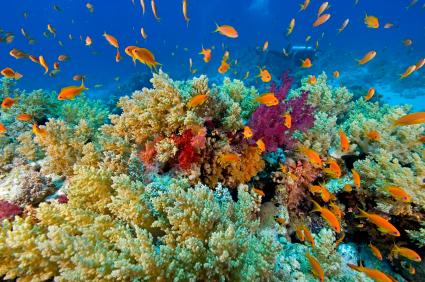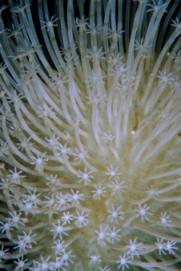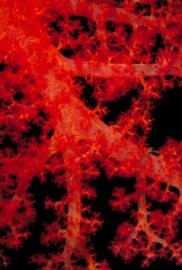Keeping Corals in Your Aquarium

There is nothing quite as beautiful as a healthy coral reef. Because corals can take on so many different colors they can add a lot of color and beauty to your saltwater aquarium.
Corals belong to the class Anthozoa, which also includes anemones. There are over 6,000 different species of coral, including both soft, leather, and stony corals.
Corals are animals that are commonly called sessile invertebrates. What this means is that they are animals that don't have a backbone (like vertebrates do) and that they are generally stuck in one spot and can't move around like most animals can. Corals are usually attached to a rock or the substrate.


Corals consist of many individual polyps. The polyps may have an internal or an external skeleton that is made of calcium carbonate.
Each polyp has an oral opening that leads to a gastrovascular tube. There is a lot of variety in the types of food eaten by coral polyps. For example, some corals feed by using their stinging tentacles to catch small fish. Other corals eat microscopic organisms, wheras some coral polyps don't feed at all, and obtain all of their nutrition from zooxanthellae (a single-celled algae that lives within the coral).
Zooxanthellae containing coral is usually of the most interest to aquarists. It is the pigments produced by the zooxanthellae that give corals their spectacular colors.
Zooxanthellae has a symbiotic relationship with corals. The corals provide the algae with protection and a place to live. The algae provides the corals with nutrients they produce by photosynthesis and they also utilize some of the coral's waste products. So in addition to providing corals with nutrition, zooxanthellae help to rid the coral of waste products as well.
Because zooxanthellae need light to undergo photosynthesis, the lighting in your reef tank is very important for keeping corals alive and healthy.
You Tube Coral Care and Feeding Video
Lighting for Your Reef Tank
In their natural environment corals are exposed to the Sun, which penetrates the water and provides the correct intensity, level, and duration of light. When choosing lighting for your corals you should aim to approximate the lighting that corals receive in their natural environment.
Factors that determine the type of lighting you need for your reef tank include the type of corals you are planning to keep. For example, corals that don't have zooxanthellae living within them can't handle intense lighting as well as those corals that contain zooanthellae. This is because the zooanthellae algae helps to protect the coral from UV rays.
If you have different types of corals in your tank with different light intensity needs, you can position them either higher or lower in the tank to adjust the amount of light they receive. In general, soft corals don't need as much light as hard corals.
Light Wavelengths
Light is made up of many different wavelengths described in nanometers. Lights with long wavelengths toward the red end of the spectrum have long wavelengths and short frequencies. At the other end of the spectrum (blue and violet) are the short wavelengths and high frequencies.
For aquarium purposes, what is important to know about the different wavelengths is that when light is filtered through water the red wavelengths are absorbed first and usually don't reach the bottom of the tank. Only the blue wavelengths reach the deeper levels of the aquarium.
Don't use aquarium lights that are designed for freshwater fish. These emit light with only long wavelengths (the red end of the spectrum) and are not suitable for the reef aquarium.
There are two types of lights that can be used for a reef aquarium: metal halide lamps and fluorescent lights.
Fluorescent lamps are less expensive than metal halide lamps and they produce less heat. However, if you use fluorescent lamps for your coral reef you need to use two different types of bulbs.
One type of bulb is going to approximate the conditions of the midday Sun on the coral reef. This light should have a color temperature of at least 6500 °K.
Although the color spectrum is based on nanometers, you'll often see the color temperature distribution described as degrees Kelvin. So, when you are looking for reef lighting you'll often see full daylight lamps described as 6500 °K or 10,000 °K. These would be full color spectrum lamps approximating the midday Sun on the reef.
The other type of fluorescent lamp is the blue or actinic lamps. These have a wavelength that ranges from aobut 350-480 nm. The best lighting for your coral reef consists of both types of lights. In general, you should keep the daylight lamps on for approximately 8 hours per day and then turn these off. Then you should turn the blue lamps on for another 8-12 hours per day. Aquarium hoods are available that hold the 2 different types of bulbs.
Instead of using fluorescent lamps you can use metal halide lamps. Metal halide lamps provide light that penetrates the water more deeply than the "daylight" fluorescent lamps. The drawback to metal halide lamps is that they are more expensive and they also produce more heat than fluorescent tubes do. In my opinion, using fluorescent lamps for your coral is the best choice as long as you use both the full spectrum and blue or actinic bulbs.
Temperature and pH
Most corals do best with a water temperature of between 72-79 °F (22-26 °C) and a pH of about 8.3. You should check the requirements of the particular species of coral you have for their exact water and lighting requirements as some corals need more light than others.
Coral Reproduction
Coral reproduction can by sexual or asexual. Some coral polyps are hermaphroditic and some are of two different sexes.
Asexual reproduction can occur by budding. Budding is the process in which the parent polyp pinches off a part of itself to form a new polyp. Corals also produce asexually when parts of a coral break off and establish a new colony in a different location from the original coral colony.
In sexual reproduction, the coral eggs are fertilized and then develop into planktonic larva, which eventually develop into small polyps that establish themselves on the substrate.
